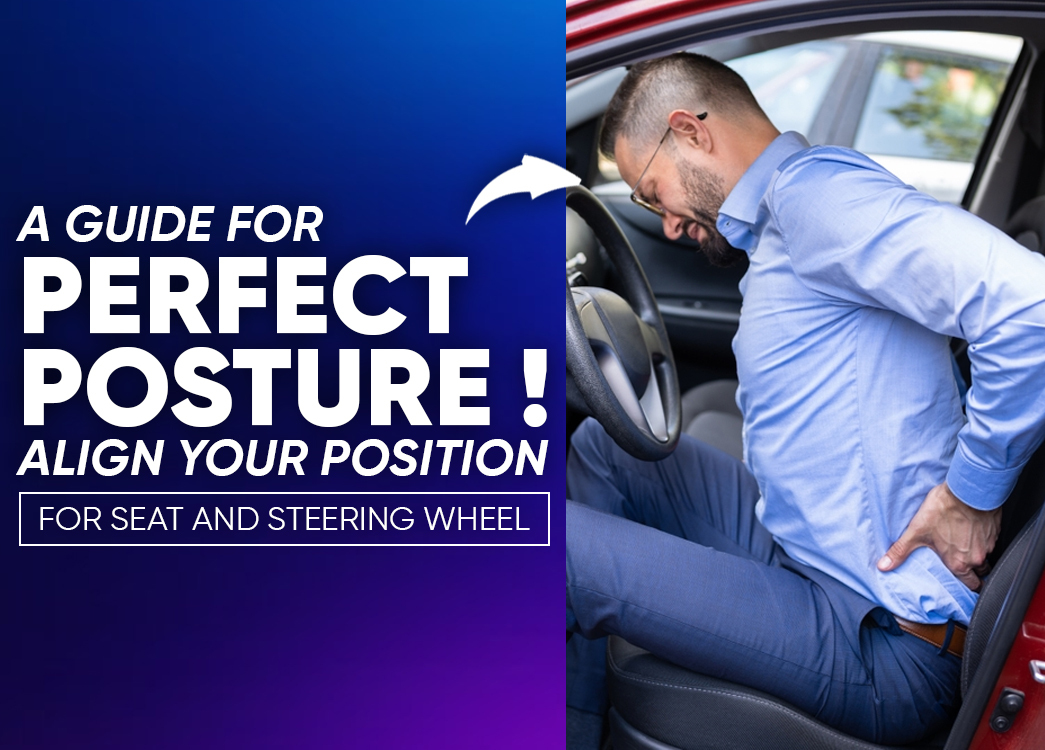
By creckk On 30-07-2025 at 5:14 am
Ergonomic Driving: How to Adjust Your Car Seat and Steering for Maximum Control and Comfort
Driving for long hours can take a toll on your posture, concentration, and overall safety especially if your seat and steering are not adjusted correctly. According to the Society of Automotive Engineers (SAE), improper seating posture is one of the leading contributors to driver fatigue and delayed reaction times.
Whether you're commuting daily or planning a long road trip, this guide will help you optimize your driving setup by adjusting your car seat and steering wheel for enhanced control, comfort, and safety.
Why Proper Seat and Steering Adjustment Matters
A properly adjusted driving position isn’t just a matter of comfort it is a key safety practice. The National Highway Traffic Safety Administration (NHTSA) emphasizes that maintaining correct driving ergonomics helps drivers stay alert, avoid injuries, and maintain full control of the vehicle in emergencies.
Benefits include:
- Reduced back and neck strain
- Better control over pedals and steering
- Optimal airbag positioning
- Improved visibility and mirror access
Step-by-Step: How to Adjust Your Car Seat
1. Seat Distance (Base Position)
Adjust the seat forward or backward so you can:
- Fully press the clutch, brake, and accelerator.
- Keep your knees slightly bent (around 120 degrees).
- Rest your heel on the floor while moving between pedals.
Tip: If your legs are fully extended or too close to the dash, readjust until you find a neutral bend in the knee.
2. Seat Height
Raise or lower the seat so you:
- Have a clear, unobstructed view of the road and dashboard.
- Maintain about 3-4 inches of clearance between your head and the roof.
- See over the steering wheel without slouching.
Proper height reduces neck strain and improves front visibility.
3. Backrest Angle
Set the backrest to support your spine naturally:
- Your back should stay in full contact with the seat.
- Avoid reclining beyond 100 degrees.
- Shoulders should stay against the backrest during turns.
A straight posture helps maintain control and prevent fatigue over long drives.
How to Adjust the Steering Wheel
1. Find the Steering Adjustment Lever
Most vehicles have a manual lever located underneath or to the side of the steering column. It allows you to adjust both tilt (up or down) and reach (inward or outward).
2. Adjust Steering Depth
With the seat fixed:
- Pull the wheel towards or away from you until your hands rest naturally at 9 and 3 o’clock.
- Your elbows should be slightly bent (approx. 120 degrees).
3. Adjust Steering Height
The wheel should be aimed at your chest, not your face. Maintain a 10-inch gap between your chest and the steering wheel to ensure safe airbag deployment.
According to NHTSA guidelines, this gap helps prevent injury during airbag inflation.
Final Checkpoints: Ergonomic Driving Checklist
- Your back and shoulders stay in contact with the seat.
- You can fully press the pedals without stretching.
- You can turn the wheel lock-to-lock without leaning forward.
- All mirrors and instruments are clearly visible.
- Your neck and spine feel relaxed, not strained.
Conclusion
Adopting an ergonomic driving posture is not a luxury it’s a safety necessity. It minimizes fatigue, maximizes focus, and significantly reduces your risk of injury during both regular and emergency maneuvers. Before starting any journey, take 2 minutes to check your setup. Your spine and safety will thank you.
FAQs: Adjusting Car Steering and Seat Position
Q1: Why is it important to adjust my driving seat before the steering wheel?
The seat determines your overall body alignment and distance from the pedals. Adjusting it first ensures the steering wheel can be positioned based on your natural posture and arm reach.
Q2: What is the safest distance between the driver and the steering wheel?
Around 10 inches (25 cm) from the center of the wheel to your chest. This provides the right space for airbag deployment and minimizes impact during a collision.
Q3: How can I tell if my seat height is correct?
You should clearly see over the dashboard and have an unobstructed view of the road while sitting with a straight back. Your eye level should be about 3 inches above the steering wheel.
Q4: What is the best angle for the backrest?
Between 95 and 100 degrees. This position supports your spine while ensuring you’re close enough to control the steering wheel without hunching forward.
Q5: Should my arms be straight when holding the wheel?
No. Arms should be slightly bent (~120 degrees) at the elbow when holding the steering at 9 and 3 o’clock. This allows full range of motion and better fatigue control.
Q6: Can improper seating position affect driving performance?
Yes. Poor posture can slow your reaction time, increase fatigue, and reduce control over pedals and steering especially during sudden braking or cornering.
Q7: Are these adjustments needed for short drives too?
Yes. Even short trips can lead to discomfort or distraction if the seat or wheel is poorly aligned. Good posture ensures you’re always ready to respond.
Related posts









